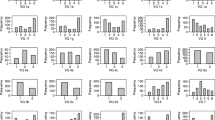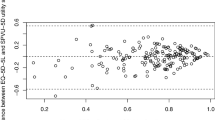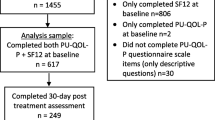Abstract
Background: Venous leg ulcers are an important source of morbidity in society. Measuring the impact of leg ulcers on quality of life is important within clinical and economic evaluations. In this study we report a validation study of the leg ulcer disease specific Hyland questionnaire and compare its discriminative and responsive characteristics to general health quality of life measures: the SF-12 and EQ-5D. Methods: HRQoL of venous leg ulcer patients from 9 UK regions was measured using SF-12, EQ-5D and Hyland, at baseline and every three months for 1 year. Psychometric analysis was used to confirm the validity of the Hyland questionnaire. Quarterly scores for all instruments were calculated. Effect size and standardised mean difference were used to investigate the responsiveness to ulcer healing and discriminative abilities of the instruments. Results: Three hundred and eighty seven individuals were recruited into the VenUS I study. Baseline health related quality of life data from the study participants suggested a two factor solution for the Hyland. This questionnaire was associated with small and moderate ability to discriminate individuals according to age, mobility, initial ulcer size and ulcer duration. SF-12 and EQ-5D had good evaluative properties; both instruments were responsive to changes in HRQoL after ulcer healing. High levels of bodily pain were reported in the SF-12 questionnaire, whilst only minor ulcer related discomfort was reported in the Hyland. Discussion: SF-12 and EQ-5D are suitable for exploring dimensions of health related quality of life in people with chronic venous leg ulceration. The responsiveness to healing of the Hyland questionnaire is unclear. We would recommend the use of generic instruments for the measurement of HRQoL in patients with venous leg ulcers.
Similar content being viewed by others
Abbreviations
- HRQoL:
-
health related quality of life
- SF-12:
-
Short Form 12
- EQ-5D:
-
Euroqol 5 dimensions
- ES:
-
effect size
- MSD:
-
mean standard difference
- PCS:
-
Physical Component Score
- MCS:
-
Mental Component Score
References
SK Chase M Melloni A. Savage (1997) ArticleTitleA forever healing: The lived experience of venous ulcer disease J Vasc Nurs. 15 73–78 Occurrence Handle9238945
C. Walshe (1995) ArticleTitleLiving with a venous leg ulcer: A descriptive study of patients’ experiences J Adv Nurs. 22 1092–1100 Occurrence Handle8675863
B Ebbeskog SL. Ekman (2001) ArticleTitleElderly persons’ experiences of living with venous leg ulcer: Living in a dialectal relationship between freedom and imprisonment Scand J Caring Sci. 15 235–2343 Occurrence Handle11564231
C Hyde B Ward J Horsfall G. Winder (1999) ArticleTitleOlder women’s experience of living with chronic leg ulceration Int J Nurs Pract. 5 189–198 Occurrence Handle10839029
R Flett B Harcourt F. Alpass (1994) ArticleTitlePsychosocial aspects of chronic lower leg ulceration in the elderly West J Nurs Res. 16 183–192 Occurrence Handle8203138
B Roe N Cullum C. Hamer (1998) Patients’ perceptions of chronic leg ulceration. Leg Ulcers; Nursing Management. A Research Based Guide Balliere Tindall London. 125–134
U Wissing AC Ek M. Unosson (2001) ArticleTitleA follow-up study of ulcer healing, nutrition, and life-situation in elderly patients with leg ulcers J Nutr Health Aging. 5 37–42 Occurrence Handle11250668
SJ Walters CJ Morrell S. Dixon (1999) ArticleTitleMeasuring health-related quality of life in patients with venous leg ulcers Qual Life Res. 8 327–336 Occurrence Handle10472165
PJ Franks CJ. Moffatt (2001) ArticleTitleHealth related quality of life in patients with venous ulceration: Use of the Nottingham health profile Qual Life Res. 10 693–700 Occurrence Handle11871590
M. Hyland (1994) ArticleTitleQuality of life of leg ulcer patients: questionnaire and preliminary findings J Wound Care. 3 294–298
R Launois J Reboul-Marty B. Henry (1996) ArticleTitleConstruction and validation of a quality of life questionnaire in chronic lower limb venous insufficiency (CIVIQ) Qual Life Res. 5 539–554 Occurrence Handle8993100
M Augustin W Dieterle I Zschocke et al. (1997) ArticleTitleDevelopment and validation of a disease-specific questionnaire on the quality of life of patients with chronic venous insufficiency Vasa. 26 291–301 Occurrence Handle9409180
J Ware SuffixJr M Kosinski SD. Keller (1996) ArticleTitleA 12-Item Short-Form Health Survey: construction of scales and preliminary tests of reliability and validity Med Care. 34 220–33 Occurrence Handle8628042
P. Kind (1996) Quality of Life and Pharmacoeconomics in Clinical Trials Lippincott–Raven Philadelphia.
M. Hyland (2003) ArticleTitleA brief gruide to the selection of quality of life instrument Health Qual Life Outcomes. 1 24–28 Occurrence Handle12848895
Norusis M. (1986). SPSS for windows (Version 10.0)
R. Cattell (1966) ArticleTitleThe scree test for the number of factors Multivar Behavi Res. 1 245–276
P. Kline (1988) Psychology Exposed: Or, The Emperor’s New Clothes. Routledge London
Friendly M. Planning a factor analytic study, 2003. http://www.psych.yorku.ca/lab/psy6140/fa/facplan.htm
LJ. Cronbach (1951) ArticleTitleCoefficient alpha and the internal structure of tests Psycometrika. 16 297–334
Kind P, Hardman G, Macran S. (1999). UK Population Norms for EQ-5D. 172. Centre for Health Economics Discussion Paper, University of York.
CP Iglesias YF Birks DJ. Torgerson (2001) ArticleTitleImproving the measurement of quality of life in older people: The York SF-12 QJM. 94 695–698 Occurrence Handle11744790
RD Crosby RL Kolotkin GR. Williams (2003) ArticleTitleDefining clinically meaningful change in health-related quality of life J Clin Epidemiol. 56 395–407 Occurrence Handle12812812
Fairclough DL. (2002). Design and Analysis of Quality of Life Studies in Clinical Trials. Chapman & Hall/CRC
H Goldstein W Browne J. Rasbash (2002) ArticleTitleMultilevel modelling of medical data Stat Med. 21 3291–315 Occurrence Handle12375305
H Goldstein NJR Healy J. Rasbash (1994) ArticleTitleMultilevel time series models with applications to repeated measures data Stat Med. 13 1643–1655 Occurrence Handle7973240
Spiegelhalter DJ, Thomas A, Best NG. (2003). WinBUGS Version 14. MRC Biostatistics Research Unit Cambridge
Gelman A. (2004). Prior distributions for variance parameters in hierachical models. In: Econometrics from Economics Working Paper Archive at WUSTL
Abrams KR, Brazier J, O’Hagan T, Kharoubi S, Tsuchiya A. (2003). Modelling partially & completely missing preference based outcome measures (PBOMs). http://www shef ac uk/chebs/FFortnights/FF6/Abrams ppt
Iglesias CP, Nelson EA, Cullum N, Torgerson DJ. (2004). VenUS I: A randomized controlled trial of two types of bandage for treating venous leg ulcers. Health Technol Assess NHS R&D HTA Program. 8
Ware JE, Kosinski M. (2001). SF-36 Physical and mental health summary scales: A manual for users of Version 1.2.
C Iglesias DJ. Torgerson (2000) ArticleTitleDoes length of questionnaire matter? A randomised controlled trial of response rates to a mailed questionnaire J Health Serv Res Policy. 5 219–221 Occurrence Handle11184958
Author information
Authors and Affiliations
Corresponding author
Rights and permissions
About this article
Cite this article
lglesias, C.P., Birks, Y., Nelson, E.A. et al. Quality of life of people with venous leg ulcers: A comparison of the discriminative and responsive characteristics of two generic and a disease specific instruments. Qual Life Res 14, 1705–1718 (2005). https://doi.org/10.1007/s11136-005-2751-9
Received:
Issue Date:
DOI: https://doi.org/10.1007/s11136-005-2751-9




